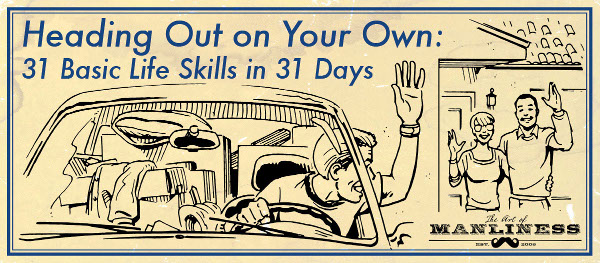
This article series is now available as a professionally formatted, distraction free paperback or ebook to read offline at your leisure.
As “Heading Out on Your Own: 31 Basic Life Skills in 31 Days†draws to a close today, we’d like to use the final post in the series to discuss a saying your grandfather was probably quite fond of: “A place for everything and everything in its place.â€
Your great-grandfather likely used that maxim too, and his grandfather as well. It actually first appeared in print way back in 1640. The saying was born among sailors, who needed to both keep things orderly in the tiny galleys and cabins below deck, and to make sure all their tools and ropes were placed and secured properly up above, so that things didn’t wash overboard when the ship was rocked by storms and waves.
“First then, while you are little boys, let there be order in everything. Try and have a place for everything and everything in its place. If your father has things in that way, see that you place everything back after using it. Hours, days, yea, months and years, are wasted by too many in hunting tools and farming implements; time thus wasted is time needlessly lost, precious time that will never return…I mention this first because it is first in importance. It governs your every act through life. If you start life thus and have a place for everything, you cannot fail to make good farmers.” –Report of the Secretary of the Iowa State Agricultural Society, 1865
“A place for everything and everything in its place†came ashore in the 19th century, and was adopted most rigorously by farmers, who owned and used a wide variety of tools and pieces of equipment, and who couldn’t afford to leave them to rust in the rain or exposed to elements during winter. Keeping track of their tools ensured they could get to work when they needed to, and there was always plenty of work to be done.
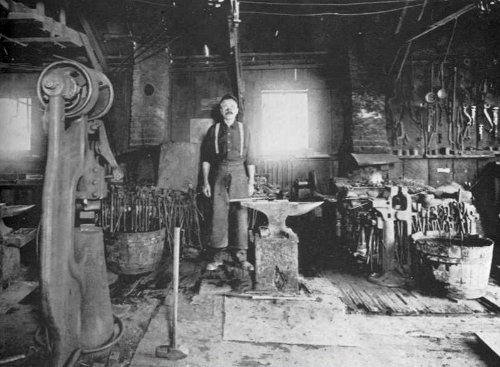
The maxim was subsequently taken up by men in all trades and businesses, white and blue collar alike, who saw how having a set place for their tools and papers, both at home and at work, contributed to their success. The standard espoused in old books was for a man to be able to dress himself in the dark or find any tool in his shed with his eyes closed.
While a man’s tools and necessities may have changed over the centuries, the wisdom in “a place for everything and everything in its place†remains the same. Whether at school, work, or home, creating a system of order for your possessions will create numerous benefits in your life.
The Importance of Having a Place for Everything and Everything in Its Place
“Soldiers of every grade must especially avoid slovenliness: they must bear in mind the proverb, ‘A Place For EVERYTHING AND EVERYTHING IN ITS PLACE’…When a soldier can bring himself to be habitually exact in small things, he may be safely regarded as reliable in important matters: but he who is negligent over apparent trifles, will find it difficult, if not impossible, to be punctual on occasions of the greatest moment.†–The Manual of the Patriotic Volunteer on Active Service in Regular And Irregular War, 1855
Having a place for everything and everything in its place saves time (and sometimes opportunities, too). Do you know someone (perhaps yourself!) who spends ten minutes looking for his keys every single morning? Or a gent who every time he leaves the house, must turn it inside out searching for his wallet? When you have a set place for all of your possessions, you can grab them and go. You’ll never be late for a job interview, date, or other important event for a silly reason like not being able to find something you need.
If you’re in the habit of haphazardly dropping things around the house, you may do so because you feel it takes too much time to put them in their proper places, or because you’re just too tired from a long day of work. But by spending and expending a minute of time and a bit of energy now, you’ll save yourself from a ten minute hunt and a lot of hassle the next day.
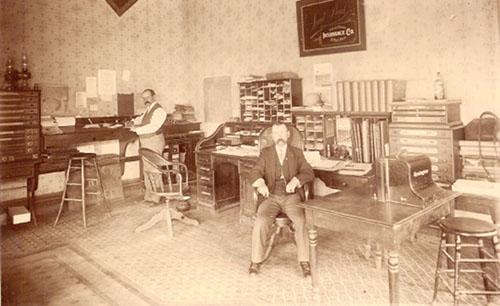
Having a place for everything and everything in its place saves money. Sometimes a hunt for a lost item comes up empty – it is never found again, forcing you to buy a replacement. You don’t have any idea what happened to it – and that’s precisely the problem. There’s no set place you keep it, so it could have ended up anywhere.
Sometimes a misplaced item is eventually found – but because it was stored carelessly, it was damaged, and you still have to buy another.
In our post about being a savvy consumer, we mentioned that a man should not seek to own a great many things, but that those things he does possess should be of good quality. Well, once a man obtains a quality item, he must then take care of it in order to make it last. To live the principle of “a place for everything and everything in its place,†is to refuse to follow the dictums of a disposable society.
Having a place for everything and everything in its place will make life smoother and less stressful.As we’ve mentioned a few times during this series, keeping your place in order gives you a sense of peace and confidence, and conserves your willpower. Being able to get out the door without first running around like a headless chicken only adds to this invaluable sense of calm and control.
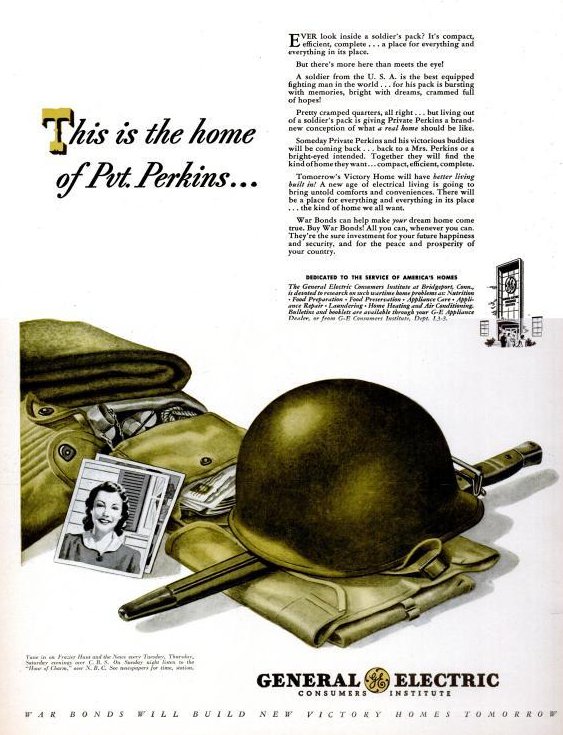
“Your safety and comfort in the field will depend upon the manner in which you keep your arms and equipment. You must take particular care not to lose them, as you may not be able to replace them by the time you will need them most. Before dark, place everything where you can quickly find it in the dark. Remember that carelessness in the protection and condition of your arms and equipment may cost you your life or health, or that of a comrade.” –Army Field Manual 21-100, 1941
Having a place for everything and everything in its place prepares you for an emergency. At boot camp, members of the armed forces are rigorously drilled in strict discipline – their uniforms, beds, and lockers must all be kept just so. For a soldier, attention to little details can mean the difference between life and death. He needs to know where his equipment is every moment — an attack can come any time so he must be always ready to spring into action.
While your abode may never come in for a shelling, it’s nice to know that if you ever had to run out the door quickly or jump out of bed in the middle of the night, you could dress yourself, grab what you needed, and be gone in a flash. By the way, according to ITS Tactical, the proper order of dressing when awakened during such a crisis is pants, socks, then shoes.
A Place for Everything

Now obviously, in order to have everything in its place, you have to establish the places you’re going to put your things. Your selection of places shouldn’t be done willy-nilly, either; if they’re inconvenient or ill-chosen, you won’t use them, and the habit of putting things there won’t stick. The place should be intuitive – putting your stuff in it should require the least possible thought and effort. It should be entirely natural. You’re not going to want to climb on a chair to reach a shelf to retrieve and replace something every day, for example. The place you choose to put something has to preserve the quality of the item and protect it from damage as well.
Of course there are as many methods for storing things as there are different items to be stored, and every man will have his own system. Below I walk you through the possible placement of some of the most common possessions for men, as well as offer my personal suggestions on how to organize and store them.
Pocket Contents
We men often carry around a lot in our pockets — smartphone, wallet, pocketknife, handkerchief, keys — and so on. We need these items every day, so they should be as easy as possible to grab each morning when we head out the door.
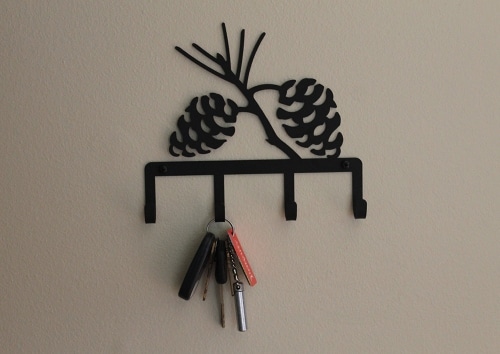
Key hook. The minute you step through the door — keys go up on the key hook. Now this isn’t strictly necessary if you have a dresser valet/box (see below) into which you plan to deposit your keys along with the rest of the contents of your pockets when you change into your lounging wear or pajamas. But even then, if you share the car with someone else or don’t have a habit of putting your keys back into your pocket and instead tend to plop them on the counter or couch, the key hook still comes in handy. There will also be times when you want to retrieve something from your car, but don’t want to walk into your bedroom to get the keys.
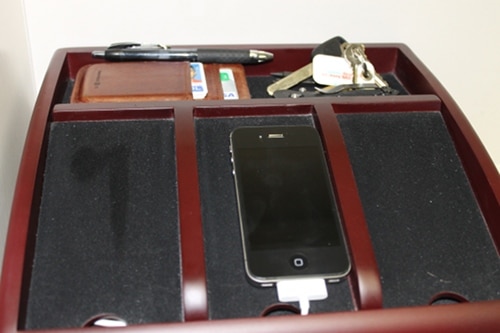
Put your phone, pocketknife, wallet, spare keys, etc into a dresser valet or other receptacle.
Dresser valet. Instead of dumping all of your pocket accoutrements on top of your dresser at the end of the day, depositing various items around the house, or leaving them in the pockets of the pants sitting in your hamper, place them all in a dresser valet. That way in the morning you can grab everything you need without spending ten minutes looking for your phone and keys.
Nice dresser valets with drawers and chargers for your phone and whatnot are available, but if you’re just starting out and on a budget, a $3 basket from Hobby Lobby or even a topless shoebox will do — anything that keeps your stuff together in one place will work fine and dandy.
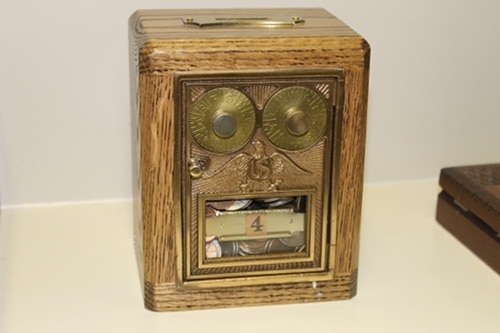
Kate got me this coin bank for Christmas one year. It’s made with the door of an old post office box.
Coin bank. Coins always somehow end up in every conceivable nook and cranny in your house. So every man should have a bank in which to place his change. It’s really worthwhile to pick change up wherever you see it at home and when you’re out and about as well, and then to deposit it in your bank at the end of the day. I knew a guy who would actually throw away his pennies! Foolishness! Just save your coins for a long time, and then put them into rolls, and exchange the rolls for cash at the bank (unless they have a handy coin-counting machine you can dump your whole loose stockpile into) — you’ll be surprised how much green stuff your pocket change will amount to. There’s something so satisfying about turning your coins into cash.
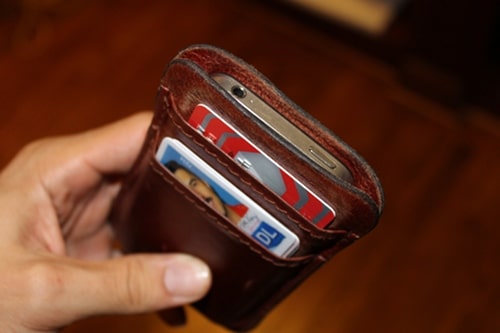
I have a wallet that also holds my iPhone. I find that keeping them together this way is quite handy.
Wallet. If you don’t keep your wallet organized, it can quickly swell to George Costanza-sized proportions. An overstuffed wallet looks silly when you pull it out, is uncomfortable to carry in your pants, and makes your jacket lopsided when kept in a jacket pocket (not to mention possible back problems if you’re sitting on it all day). A giant wallet can also create creases in your pants or jacket which can shorten the life of the garment.
So clean out your wallet regularly, and only put things in it that belong there:
- Keep: Cash, credit cards, ID cards, business cards, photos of loved ones
- Remove: Discount club membership and library cards (keep in car, or grab for a specific trip when you’ll need them), Social Security card (very risky if wallet is stolen — keep at home), condoms (can degrade in your wallet), receipts (transfer to files when you get home — see below), too many coins (unless it’s a major part of the currency in your country)
For more about maintaining your wallet, see this AoM guide.
Clothes and Accessories
Clothing is an area where our best-laid plans for order often go awry: our garments frequently end up slung over chairs, tossed on the bed, crumpled in piles on the floor, and spilling out of dresser drawers.
But by the same token, taking time to put away our clothes properly will go a very long way in keeping our bedrooms looking neat. Getting ready in a messy environment puts you in an out of sorts mood right from the get go, whereas waking up to a neat room in the morning really helps get your day started off on the right foot. Plus, proper care and storage of your clothes will make them last longer, saving you big money.
Dresser. There are a variety of ways to organize your dresser — you might choose to group clothes together by weight, season, or use. It also depends on how many drawers your particular dresser has. Here’s how I do mine:
- Top drawer: underwear, socks, undershirts.
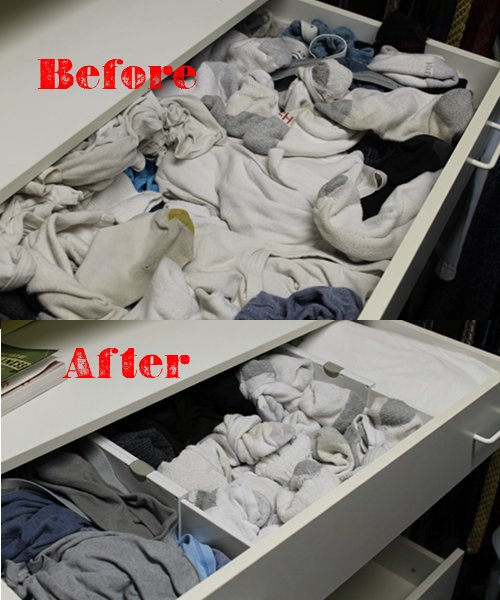
Drawer dividers are handy for keeping your underwear/sock drawer from becoming a chaotic mess and can help organize your others drawers as well. The expandable dividers seen here are quite handy, but a little pricey; if you’re on a budget, shoe boxes or tissue boxes from which the top panel has been removed can also work.
- Second drawer: Fill it with the things you reach for most. Mine has got t-shirts and workout clothes.
- Third Drawer: Shorts, pants, sweaters. You might also put these types of items on a shelf in your closet.
I put my seasonal-specific clothes in a plastic tub depending on the season, and then rotate them into the dresser as the weather warms or cools.
More dresser tips:
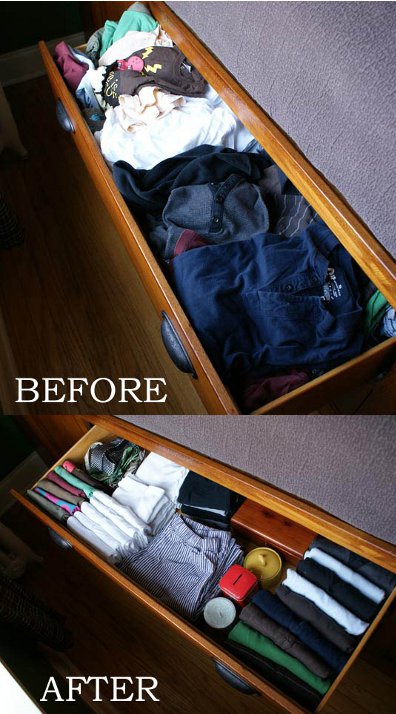
Image from Apartment Therapy
- Even when you stack your clothes into nice piles inside your dresser drawers, as soon as you pull something out that’s in the middle or bottom of the stack, the piles topple over into a mishmashed heap. A method that will keep things a bit neater is the file fold method. My drawers are too shallow for it, but it allows you to see all your garment choices and draw one out without disrupting things. If you want to give it a try, let this nice lady show you how:
- Twice a year, take everything out of your drawers, remove anything you haven’t worn in a year and donate those garments, then refold everything and put it back.
Closet rod. Some men do away with the dresser altogether, getting a little two-drawer container for socks and underwear and hanging everything else up. I’m personally kind of weirded out by t-shirts and jeans that are hung up, but to each their own. There are, however, some things that regardless of whether you have a dresser or not should be hung up, and hung up properly. The following tips will help prolong the life of your clothes, and ensure they’re ready to wear when you take them off the hanger:
- If your hang-able clothes are still clean when you take them off, put them right back on a hanger instead of leaving them crumpled up on the floor, which will create stubborn wrinkles. Hanging your worn garments will allow them to return to their natural shape.
- Check the garment for stains and offending scents before returning it to the hanger.
- Remove belts and heavy items in the pockets before placing the garment on the hanger, as they will stretch and distort it.
- Button the top and third button down on shirts to prevent wrinkles and the collar from spreading out on the hanger.
- After hanging up a suit or dress trousers you’ve worn that day, brush the garment gently with a clean, natural bristle brush. Doing this removes dirt and food that has accumulated on the outer layers before they have the chance to settle into the fabric. Regular brushing can double or even triple the time between which a garment will need to be taken to the cleaners.
- Never use wire hangers to hang any of your clothes. With too little surface area to properly support the garment, the wire will cut into the fabric and cause creases and damage.
- Use quality wood shirt hangers (at least ¼ inch thick) and wood suit hangers (at least 1+ inch thick at the shoulders) to hang up your suits and nice shirts. Quality hangers are a little pricey, but certainly worth it when it comes to prolonging the life of a $400 suit
- Don’t put sweaters and knit shirts on a hanger, even a wide one, as it will stretch them. Store sweaters and the like in your dresser or on a closet shelf.
- Don’t crowd clothes together on the closet rod — maintain at least 1/2 inch between garments for airflow and ease of selection. This will give odors a chance to dissipate, and prevent the creasing, wrinkling, and fuzz transfer that can result from garments being smooshed together.
- Give clothes, especially nice items like suits, a day to rest in-between wearings when possible. This will give the fabric time to release its moisture, reshape, and rejuvenate.
- If clothing is going to be hung for more than a couple of months without being worn, consider placing it in a breathable garment bag to prevent dust accumulation.
For more tips on caring for your wardrobe, see this AoM guide.
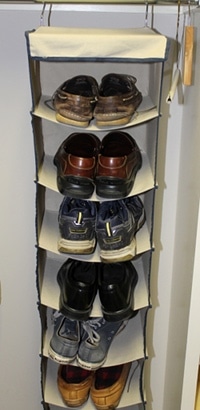
Shoe organizer. Shoes tend to get left everywhere and end up all over the house or the closet floor. We’ve all had those frustrating times where we can find one shoe, but not the other, even when we’re sure its mate must be close by! So get a shoe organizer — they come in a variety of styles from space-saving ones that hang from your closet bar, to racks that sit on the floor.
Here are a couple of additional shoe storage tips:
- When you remove leather shoes, slip a cedar shoe tree inside them. Shoe trees maintain the shape of the shoe, prevent the leather from warping in a way that would promote premature cracking, absorb excess moisture from the soles and leather, and prolong the life of the shoes.
- Give your shoes a 24-hour breather between wearings when possible to allow them to shed their moisture and rejuvenate.
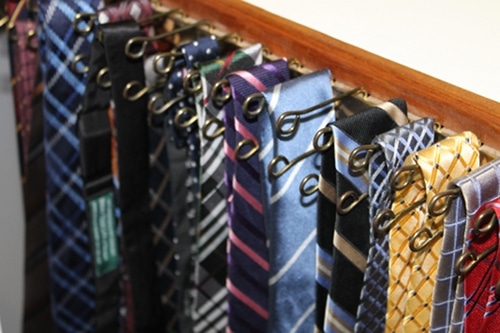
Tie rack. Ties are often made from high quality, but fragile, materials like silk. So you want to take care of them in a way that prolongs their life. That care begins with getting a tie rack. The best way to store your ties is vertically, as the gravity will naturally smooth out their wrinkles.
More tie care tips:
- Store knit ties by rolling them up and placing them in a box or drawer. Hanging up a knit tie will stretch it out.
- Always untie your tie all the way when removing it. To save time, or because they fear they won’t remember how to tie the same knot again, some men leave their ties tied, and just loosen the knot enough to slip it over their heads. The next day they slip the tie back on, and tighten it up. Don’t do this. Leaving a tie tied will damage the fabric and shorten its lifespan over time.
- Instead of yanking off the tie and stretching the fabric, remove it using the same steps you tied it with, only now in reverse order. This method is the gentlest way to remove a tie.
- As with your other nice clothes, try to give ties a day of rest between wearings, to allow them to regain their natural shape.

Silent valet. Also known as a “clothes valet,” or “valet stand,” these fixtures were popular with the gentlemen of yesteryear. They’re designed for the efficient man who wants his morning routine to be as smooth and stress-free as possible. Silent valets are set up to let you lay out your entire outfit for the next day the night before (and to hang up your clothes at the end of the day). They come with a place to hang your suit jacket, pants, shirt, and tie, along with a shelf for your shoes and a drawer for your pocket accoutrements. I’ve never tried one myself, but have had several readers email me about them over the years to sing their praises. If this is something that interests you, here is a plan from a 1956 issue of Popular Mechanics on how to build one yourself:
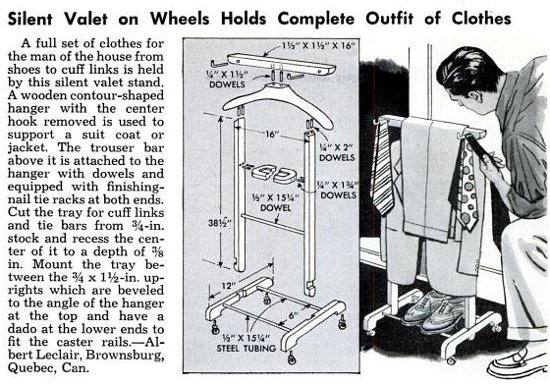
Document Box
As you set up a life on your own, you’ll begin to accumulate a boat load of important documents like tax returns, college transcripts, car titles, rent leases, and credit reports. You’ll likely encounter situations where you’ll be required to cough-up these documents in order to file your taxes or to prove you’ve paid for something. You don’t want to waste hours of your life searching every nook and cranny in your apartment for a stupid piece of paper simply because you didn’t take the time to organize your paperwork.
One habit I recommend starting right away is filing important paperwork in a document box (or file cabinet, if you have one). Your box doesn’t have to be anything fancy. My first document box was just a cheap plastic container you can pick up at any office supply store for $10. Now I keep most of mine and Kate’s important paperwork in a file drawer. I recently acquired a safety deposit box where I plan on putting a few of my really important legal documents.
What sort of documents should you file away in your document box? There are seven broad categories of paperwork you should plan on keeping. Create a folder for each and start placing the suggested documents in them.
Society is at a crossroads where many documents can be digitized and found online, while some things still require a hard copy. If you can digitize something, do it. But when in doubt, retain a hard copy, too.
Identification
- Certified copy of your birth certificate. Your parents probably have your original birth certificate on file. Before you leave home, get your own certified copy. You’ll need it every now and then to prove your identification, like when you apply for a passport. You’ll need to contact the vital records service of the state you were born in to get your copy.
- Social Security card
- Passport
- Photo copy of your driver’s license
Insurance
Create a folder where you’ll store all the documents relating to the various types of insurance you may have. One folder labeled “Insurance” should be enough when you’re first starting out. As you acquire more types of insurance, you can get more granular with your foldering. Your folder should have copies of:
- Car insurance policy
- Health insurance policy
- Renter’s or home insurance
- Life insurance policy
- Disability insurance policy
School
When you’re applying for graduate programs or jobs, you’ll likely need copies of your transcripts and diplomas. Store those in a folder labeled “School.”
Medical
- Immunization record
- List of allergies
- Names and numbers of doctors. When you visit a new doctor, they’ll likely call your previous doctor to get your medical records. It’s nice to have those numbers handy.
- Eyeglass/contacts prescription
Legal
While you might not have too many legal documents when you’re first starting out in life, it’s a good idea to create a folder for the ones you’ll likely collect throughout adulthood.
- Rental leases
- Power of attorney
- Advanced directive (living will)
- Will (when you get one)
- Marriage license (when you get hitched)
- Any other contracts you enter into
Financial
Place all your financial related documents in this folder. These include:
- Bank statements for your checking and savings account
- Info about your retirement savings
- Info about your loans
Warranties/Receipts/Owner’s Manuals
I like to have a folder where I stash all the documents for all my big purchases. Whenever one of my appliances goes kaput, I know exactly where to find the owner’s manual and receipt. Much better than searching random kitchen drawers for those things. Of course, many manuals can be found online these days, so you can go that route, although it’s still nice to have something you can easily crouch down with in the basement or something.
It’s also a good idea to digitize receipts. That way if you’re out and about, you can access them anywhere, anytime on your phone.
Taxes
When you’re done filing your taxes, you need to hold onto a copy of your return and the accompanying paperwork for a few years because, 1) you might get audited by the IRS, and 2) you never know when you’ll need to report your previous year’s income for a rental agreement or loan.
Create a folder for each year’s taxes. I always start mine January 1st. That’s when I begin collecting all the paperwork so I can file by April 15. After I’ve shipped everything off to the IRS, I place my folder that contains the copy of the return along with other documents in my file drawer.
How long should you keep old tax files? It depends. If you’re a salaried employee working for someone else, three years should be sufficient. The IRS can audit these types of filers for any reason within a three year period. If you own a business or your taxes are more complex, hold onto your files for at least six years.
Tools and Emergency Supplies
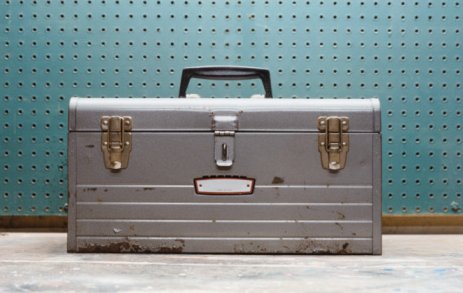
You should also have a dedicated place where you keep all of your tools and emergency supplies — these are things you definitely don’t want to be running around hunting for when you need them! Check out these AoM guides for information on what kinds of tools and emergency equipment you should have stored carefully and at the ready:
- 12 Tools Every Man Should Have in His Toolbox
- 13 Things a Man Should Keep in His Car
- How to Make a Bug Out Bag: Your 72-Hour Emergency Evacuation Survival Kit
Do It Now!
So you’re committed to adopting “a place for everything and everything in its place” as a maxim in your life, and you’ve established the best places to put your things. How do you now develop the habit of actually putting your things in those places?
By living the principle of Do It Now!
Without constant, small exertions of effort, your life will always tend towards chaos. Always doing the little things that need to get done right away will prevent them from piling up into a giant, overwhelming mess that can get your life off track, or, at the least, add unnecessary stress to it.
As soon as you’re finished using something, put it away. As soon as something you need to do crosses your mind, take care of it immediately. When you open a cabinet to get something, close it. When you run out of TP, put another roll on the holder. When you take off your clothes, put them in the hamper. When you drop something on the floor, pick it up. By living the principle of Do It Now, you can easily keep your house and life in order and live with a manly sense of peace and confidence.
To illustrate the Do It Now principle, we had actor and filmmaker Jordan Crowder produce an awesome video in the style of the 1950s instructional films we’ve included in a couple of the posts in this series:


